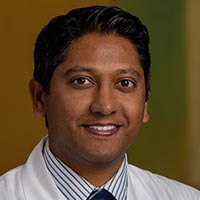New Patient Appointment or 214-645-8300

John Thottakara, M.D. Answers Questions On: Stroke Recovery
-
Can rehabilitation help stroke patients recover functional ability?
-
Although most recovery in motor function (movement and strength) occurs within the first six months of stroke, many patients’ functional abilities can and often do improve beyond that time frame with coordinated rehabilitative therapy that targets the related deficits.
In many cases, combining therapy with medical management can be helpful, as well. For instance, for patients with profound spasticity that’s causing difficulty with their mobility or activities of daily living, we often improve their function by prescribing oral medications or performing neurotoxin injections.
While not all stroke patients are able to recover lost function, our team of specialists is able to help many patients improve.
Early therapeutic intervention has been proven to positively impact long-term functional outcomes, so that’s key. If patients can tolerate working with a therapist, it’s very important to their recovery that they do that – and do it as soon after a stroke as their doctor recommends.
-
Who’s involved with stroke rehabilitation?
-
Rehabilitation medicine is a collaborative effort, whether we’re helping someone recover from a stroke or another type of medical event, injury, or illness.
At UT Southwestern, physical therapists address mobility issues; occupational therapists help people perform daily-living activities; speech therapists address swallowing, cognitive, and language concerns; neurologists manage issues such as seizures and movement disorders; and ophthalmologists help with vision concerns.
Getting the most out of rehabilitation depends on more than the physicians, therapists, and other specialists. It also depends on the patients themselves – how much they can do for themselves and how motivated they are to get better and participate in rehabilitation-related therapies.
-
Have there been any notable advances in stroke rehabilitation recently?
-
Although not every patient is a candidate for every therapy, we’re able to offer more therapeutic options than ever to help people regain function they’ve lost due to stroke.
For example, a number of new injectable neurotoxins have come on the market in the past several years that help us manage spasticity, the muscle tightness and spasms that can result from strokes and certain neuromuscular disorders.
Pump implants also can help manage spasticity in some patients.
In addition, neuroprosthetics aimed at stroke recovery continue to improve. These wearable cuff-like devices use sensors to electrically stimulate targeted muscles in the ankles and arms to improve walking and hand usage, respectively.
Developed about 10 years ago, the devices can really benefit some stroke patients – and they’ve gotten more compact and less restrictive than they’ve been in the past.
There are now a number of medications available, as well, that we can use to manage stroke-related mood disorders, language deficits, and stimulation difficulty in some patients.